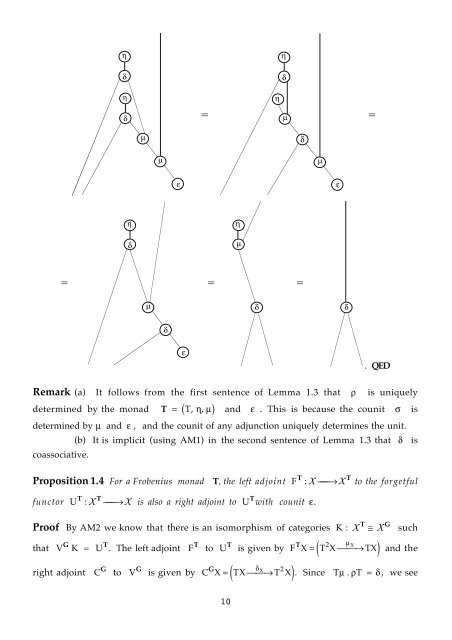Frobenius monads and pseudomonoids Introduction - ResearchGate
Frobenius monads and pseudomonoids Introduction - ResearchGate
Frobenius monads and pseudomonoids Introduction - ResearchGate
You also want an ePaper? Increase the reach of your titles
YUMPU automatically turns print PDFs into web optimized ePapers that Google loves.
=<br />
h<br />
d<br />
h<br />
d<br />
h<br />
d<br />
m<br />
m<br />
m<br />
d<br />
e<br />
e<br />
=<br />
=<br />
h<br />
m<br />
d<br />
h<br />
h<br />
d<br />
m<br />
d<br />
=<br />
m<br />
e<br />
d<br />
=<br />
. QED<br />
Remark (a) It follows from the first sentence of Lemma 1.3 that r is uniquely<br />
determined by the monad<br />
T = ( T, h, m) <strong>and</strong> e . This is because the counit s is<br />
determined by m <strong>and</strong> e , <strong>and</strong> the counit of any adjunction uniquely determines the unit.<br />
(b) It is implicit (using AM1) in the second sentence of Lemma 1.3 that d<br />
coassociative.<br />
is<br />
Proposition 1.4 For a <strong>Frobenius</strong> monad T, the left adjoint<br />
functor<br />
T T<br />
U<br />
: X æÆ æ X is also a right adjoint to<br />
F<br />
U T with counit e.<br />
T T<br />
Proof By AM2 we know that there is an isomorphism of categories K :<br />
that<br />
V G K =<br />
right adjoint<br />
U T . The left adjoint<br />
C G to<br />
V G is given by<br />
F T to<br />
U T is given by<br />
G X<br />
C X = TX ææÆT X<br />
10<br />
d 2<br />
( )<br />
: X æÆ æ X to the forgetful<br />
m<br />
( )<br />
T 2 X<br />
F X = T X ææÆTX T G X @ X such<br />
<strong>and</strong> the<br />
. Since Tm . rT = d,<br />
we see
















